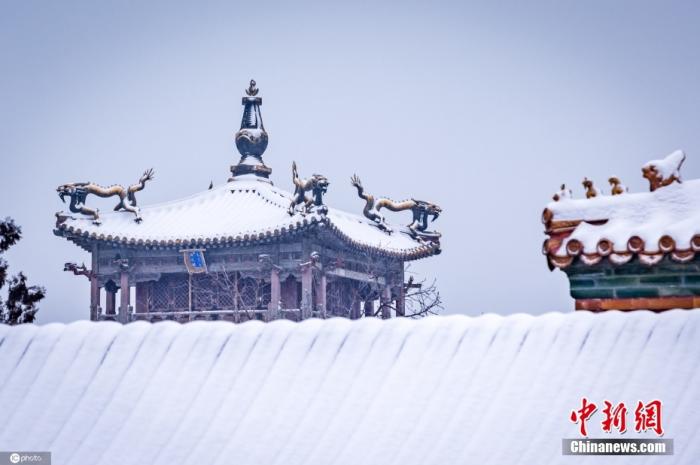China News Agency, Beijing, February 14 (Reporter Ying Ni) On the 13th, Beijing ushered in the first spring snow of the Year of the Tiger.
The Forbidden City has also been hotly searched because of this snow - six hundred years of red walls and yellow tiles and flying white snow, interweaving a wonderful scene on earth.
A romantic saying is that when it snows, the Forbidden City becomes the Forbidden City;
The real version is that as soon as it snows, the tickets for the Palace Museum will be empty in seconds!
On February 13, a spring snow came to Beijing, and the silver-clad Forbidden City had a different charm.
Tourists check in one after another to enjoy the snow scene of the Forbidden City with red walls and green tiles welcoming the spring snow.
Image source: ICphoto
This statement is true.
It was forecast to snow on February 13, and tickets for the Forbidden City were almost sold out a few days before.
The "little masters" who can "enter the palace" directly on the same day all hold the artifact of the Forbidden City Annual Pass.
In the snowflakes flying, Gege, concubines, and queen mothers "appeared" one after another. Don't be surprised if you see Jin Yiwei wearing a flying fish suit. After all, the Forbidden City was the home of the emperors of the Ming and Qing dynasties.
Of course, ancient costumes are not limited to the Ming and Qing Dynasties. Many tourists dressed in Hanfu, cloaks, appliqués, Dai Buyao, and fans are walking in the snow. Affect their enjoyment in the snow.
On February 13, Beijing ushered in the first snowfall of the Lunar New Year of the Tiger, and people visited the Forbidden City in the snow.
Photo by China News Agency reporter Sheng Jiapeng
In fact, in addition to shooting for ancient costumes, more and more young people are now willing to travel in Hanfu.
Coming to the Forbidden City is probably one of the ultimate dreams of every antiquity lover in China.
There is no doubt that the Palace Museum is a collection of the essence of Chinese traditional culture, whether it is the essence of cultural relics collection or the wonderful construction skills.
The once "Forbidden City Run" is now sold out in seconds, reflecting the power of the revival and rise of traditional culture behind it.
Chinese people increasingly want to get close to the elements that are connected with their own blood, and it is becoming more and more common to celebrate the New Year in cultural museum venues.
On February 13, Beijing ushered in the first snowfall of the Lunar New Year of the Tiger, and people visited the Forbidden City in the snow.
Photo by China News Agency reporter Sheng Jiapeng
In recent years, the Palace Museum has also tried its best to make the image of the Forbidden City more friendly to the people, and to make the cold cultural relics and buildings warmer: using digital technology to make "Across the River During Qingming Festival" "moving", after a thousand years of the Song Dynasty Prosperity is in front of people's eyes; the cold emperor Yongzheng and Qianlong are no less than scissors and cosplay; the "Forbidden City Calendar", which comes every year as promised, has changed from red bricks to fashionable national trends, implying high technology , which is refreshing; the ridged beasts in the Hall of Supreme Harmony of the Forbidden City even turned into "cute" little monsters and entered the book and stage to mingle with the children; a picture of "A Thousand Miles of Rivers and Mountains" was activated in this year's Spring Festival Gala as the dance "Only Here" "Green", stunning the whole of China.
On February 13, Beijing ushered in the first snowfall of the Lunar New Year of the Tiger, and people visited the Forbidden City in the snow.
Photo by China News Agency reporter Sheng Jiapeng
The "Why China" exhibition being exhibited at the Palace Museum, starting from the Stone Age and down to the Qing Dynasty, can give people the most intuitive experience of the long-standing inheritance of Chinese culture: Chinese civilization began in the beginning, and the history of five thousand years of civilization began successively. , like a sky full of stars, and then condensed one by one, evolving along the integration of ethnic groups, exchanges and mutual learning, until the essence is gathered and the world is benefited.
From He Zun, who first appeared with the word "China", to the Jin Mou Yonggu Cup, which carries the meaning of "May the government communicate with people, pray for the eternal prosperity of the country", from the Hu people in the Sui Dynasty eating cakes and riding camels, and the Song Dynasty silver gilt and beaded golden wings Birds, to Xianbei Jinbuyao and Yuan Dynasty blue-and-white porcelain, the heavy exhibits at the national treasure level make people look at it for thousands of years.
The emergence of traditional culture is reflected in all aspects: one drink and one peck, shirts and hats, the Chinese have long been dissatisfied with food and clothing, and the design with cultural heritage can win the hearts of consumers; various cultural relics from Sanxingdui” "Blind Box" and the announcement of the top ten archaeological results of the year can always attract national-level attention; on the performance stage and on the big screen, there are flashes of Dunhuang Feitian, Nezha Naohai... All these are showing The temperature and tension of traditional culture.
Chinese people who are steeped in cultural self-confidence are even more daring to perform "Chinese-style romance" at the opening ceremony of the Beijing Winter Olympics, and invite the world to "go to the future together" as a master.
(Finish)

